Exploring the Beauty of Four-Prong Platinum Settings
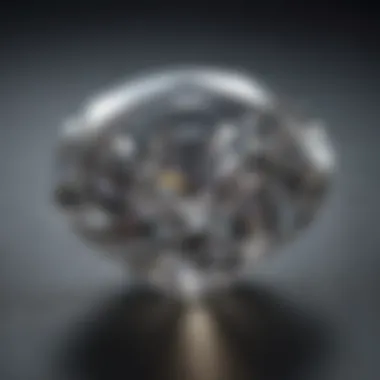
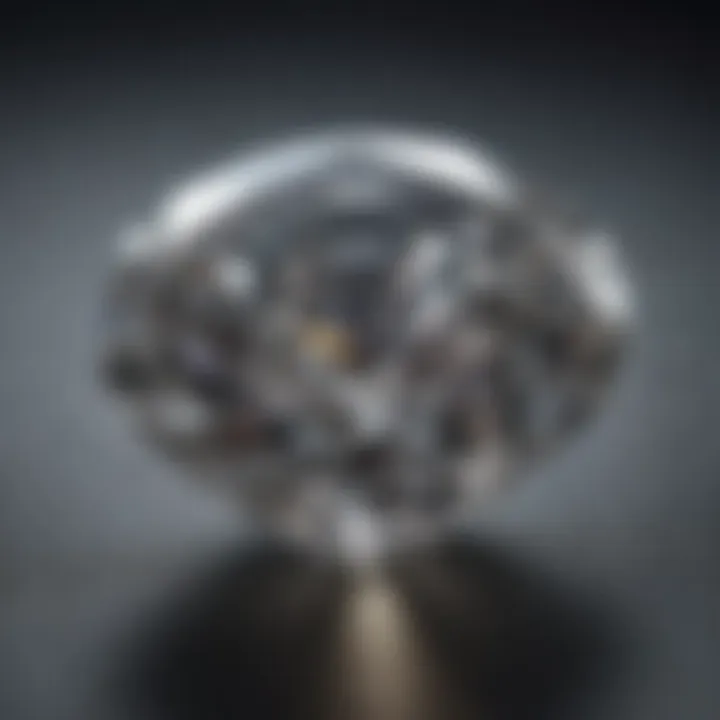
Intro
When it comes to engagement rings, the setting can be just as captivating as the gemstone it cradles. Among the myriad of choices, the four-prong platinum setting stands out, not just for its aesthetic allure, but for the security and timeless quality it offers. This article seeks to provide a thorough investigation of this classic setting's elegance, exploring its design, durability, and the emotional connections it fosters.
The heart of this piece lies not only in its visual appeal but also in its historical roots and how it has evolved over the decades. In this exploration, we will delve deep into the intricacies of the four-prong platinum setting, examining its compatibility with various gemstones, customization options, and the necessary maintenance that ensures lasting beauty. By the end, readers will be equipped with a wealth of information that enhances appreciation for this beloved choice in fine jewelry.
Gemstone Overview
Definition and characteristics
Gemstones, often regarded as nature's masterpieces, are precious or semi-precious stones prized for their beauty, rarity, and durability. In this context, the gemstones that fit snugly into four-prong settings are typically faceted to amplify their brilliance. A gemstone's clarity, color, cut, and carat weight—commonly referred to as the "Four Cs"—play pivotal roles in determining its overall value and suitability for different settings.
Classification of gemstones
Gemstones can be categorized broadly into two principal groups:
- Precious Gemstones: These include diamonds, rubies, sapphires, and emeralds. Often valued highly due to their scarcity and stunning beauty, they are the mainstay in high-end jewelry.
- Semi-Precious Gemstones: This group includes a richer variety like amethyst, citrine, garnet, and aquamarine. While they may be less expensive than precious stones, their vibrant colors and unique characteristics make them excellent choices for diverse settings.
Understanding the characteristics of these gemstones is fundamental. Not all stones hold up equally well in a four-prong platinum setting, and knowing their qualities helps jewelers and enthusiasts alike make informed decisions.
Properties of Gemstones
Physical properties
Physical properties describe how a gemstone interacts with light and physical forces. Key properties include:
- Hardness: Measured on the Mohs scale, it indicates a gemstone's resistance to scratching. Diamonds, with a score of 10, are the hardest, while softer stones like talc score just 1.
- Luster: This refers to how light reflects from a gemstone's surface. It can range from glassy to dull, affecting the overall visual impact of the stone.
- Transparency: Determines how much light can pass through a gemstone. Transparent stones, such as diamonds, allow for maximum light performance, enhancing their sparkle.
Chemical properties
The chemical composition of gemstones influences their color, clarity, and overall durability. For instance:
- Diamonds consist entirely of carbon, organized in a crystal lattice, which gives them their unrivaled hardness.
- Sapphires and Rubies, both forms of corundum, owe their colors to trace elements such as iron, titanium, or chromium.
Understanding these properties provides insight into what gemstones shine best in a four-prong platinum setting—ultimately enhancing their beauty and longevity.
“Gemstones are not just about beauty, but their juxtaposition of science and art.”
As we journey through the intricate world of the four-prong platinum setting, these foundational insights into gemstones serve as our compass. With this understanding, enthusiasts and jewelers can appreciate why this setting, in conjunction with the right gemstone, becomes a timeless treasure.
Prelims to Four-Prong Platinum Settings
The four-prong platinum setting stands as a prominent choice in the realm of fine jewelry, particularly in engagement rings. It combines elegance with functionality, making it a staple for those who value both aesthetics and durability. Understanding this setting is essential not just for jewelers, but for anyone looking to invest in a piece that may symbolize love or commemorate significant moments.
Defining the Four-Prong Setting
When discussing the four-prong setting, one might think of an arrangement that features four tapered metal claws that grasp a gemstone securely. These prongs not only elevate the gem, making it a focal point but also facilitate light entry, enhancing the stone's brilliance and fire. Each prong works like a sturdy hand, holding the gemstone in place while allowing for maximum visibility.
In practical terms, this design offers a balanced appearance; it’s not overly bulky like some other styles and has an inherent gracefulness. The prongs can come in various styles—some may be rounded, while others are more pointed. While there are more modern variations, the classic four-prong setting holds a timeless charm that appeals to traditionalists and trendsetters alike.
The Significance of Platinum in Jewelry
Platinum, often regarded as the premium metal in jewelry making, plays a crucial role in the allure of the four-prong setting. Unlike gold or silver, platinum boasts a natural white shine which does not tarnish over time. This intrinsic property means that it maintains its luster, providing a perfect backdrop for sparkling gems. Beyond its beauty, platinum's density gives it remarkable strength, making it resistant to bending and scratching—qualities that are invaluable for daily wear, especially in engagement rings.
Moreover, its hypoallergenic characteristic makes it suitable for those with sensitive skin, ensuring comfort without sacrificing style. Platinum is also rare compared to gold, adding an element of exclusivity to pieces made from it.
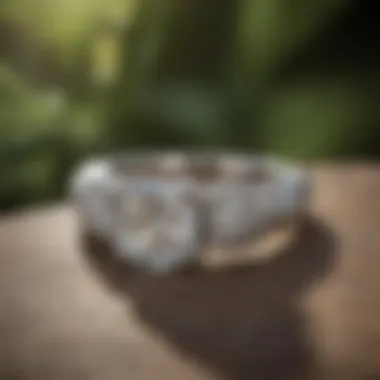
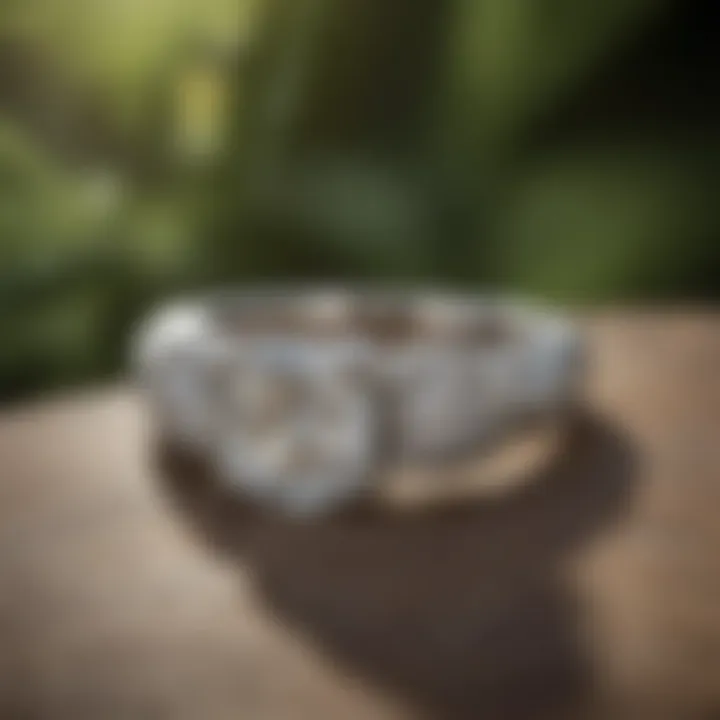
Platinum’s durability and unique visual appeal contribute significantly to the overall desirability of a four-prong setting. This combination of factors makes it a sound choice for anyone looking to invest in quality jewelry that stands the test of time.
"In choosing platinum, one not only selects a metal but embraces a legacy of elegance and resilience."
Understanding the definition and significance of these components sets the stage for appreciating the intricate beauty and reliability of four-prong platinum settings. As we delve further, the aesthetic appeal and practical considerations will reinforce the importance of this classic style.
Aesthetic Appeal of Four-Prong Settings
The four-prong platinum setting is far more than just a method of holding a gemstone in place. It's an art form that combines functionality with visual delight. In choosing a setting for an engagement ring or any fine jewelry piece, the aesthetic appeal is often a primary consideration. The graceful lines and elegant presence that a four-prong setting offers can make it the centerpiece of any jewelry collection.
Showcasing Gemstones Effectively
One of the standout features of the four-prong setting is its talent for showcasing gemstones with flair. The prongs, typically designed to subtly blend into the band, provide a view that is unobstructed. This means the light interacts freely with the gemstone, allowing it to sparkle and shine. This visibility is a dance of light, revealing the inner qualities of each stone.
- The elevation of the gemstone above the band not only draws the eye upward but enhances the perception of size and brilliance.
- Whether it’s a dazzling diamond or a rich sapphire, the four-prong setting highlights the unique colors and characteristics of each stone.
- Many collectors favor this design because it brings out the "fire" and color variations that may otherwise be lost in bulkier settings.
For jewelers and enthusiasts alike, the four-prong setting offers a practical yet enchanting choice. It doesn’t merely hold a gem; it makes sure the gem has its moment in the spotlight. Consider how a round brilliant diamond flags itself in such a setting: the light enters from all angles, ensuring a maximum scintillation that would make any admirer swoon.
Design Versatility and Style Options
What truly elevates the four-prong platinum setting is its versatility. This design seamlessly accommodates various styles and gem shapes, making it one of the most adaptable options in jewelry design. It can fit perfectly with modern minimalist preferences as well as traditional vintage looks, creating a broad appeal.
- Simplicity Meets Luxury: The minimalist design draws attention directly to the gemstone. Simple, elegant bands paired with a four-prong setting underline a sense of understated luxury.
- Adaptability: Available for various shapes—round, princess, oval, and even pear—the prong style remains favorable regardless of the gem's cut.
- Personalization: The setting can be tilted to create a unique tilt, or perhaps adorned with additional smaller stones on the band, adding further design layers without overshadowing the primary gem.
In this way, the four-prong setting holds an entire world of styling opportunities. Each customization, from the width of the band to the contour of the prongs, reflects personal tastes and preferences.
"The four-prong setting doesn’t just hold the gemstone; it showcases its heart and soul."
With options ranging from classic elegance to contemporary flair, it's no surprise that the four-prong platinum setting remains a staple in the world of fine jewelry. Its balance of security and style makes it a favorite, ensuring that gemstones are not just held in place but are celebrated.
Structural Integrity and Security
When delving into the world of jewelry, particularly in the realm of engagement rings, one cannot overlook the aspect of structural integrity and security. These features act like the backbone of every piece, ensuring that the jewels remain stable and stunning without compromising their beauty or the wearer's peace of mind. The four-prong platinum setting, with its unique design, brings both style and strength to the table, making it a favored choice among those in search of lasting elegance.
Understanding Prong Design
The prong design serves as the essential element of a four-prong setting. Each prong is designed to cradle the gemstone, securing it while minimizing interference with how light interacts with the gem. The placement of these prongs is not arbitrary; they are carefully positioned to offer the best balance of protection and exposure. When done correctly, the four prongs can hold a gemstone firmly in place, preventing it from shifting or becoming loose.
Moreover, the height of the prongs can be customized. Some prefer prongs that sit lower to the band, creating a sleek profile, while others may choose taller prongs to elevate the gemstone for better light reflection. This balance between aesthetics and function is a hallmark of skilled craftsmanship.
"A well-designed prong is like a good safety net; it's there to catch what matters most while letting the beauty shine through."
Durability of Platinum Compared to Other Metals
When it comes to jewelry, not all metals are created equal. Platinum, often lauded for its robustness and premium look, has unique characteristics that set it apart from other precious metals like gold or silver. Notably, platinum is denser and heavier, boasting a natural resilience against wear and tear. This intrinsic quality is vital for security in settings where gemstones are often exposed to everyday hazards.
Unlike softer metals that might bend or scratch, platinum maintains its shape and strength over time. This means that rings crafted with platinum retain their elegance and structural integrity far longer than those made from other materials. A four-prong setting in platinum not only promises a strong hold on the precious stone it houses but also reflects an enduring beauty that can withstand the test of time.
- Advantages of Platinum for Settings:
- Highly resistant to corrosion and tarnishing.
- Retains its weight and does not wear down easily.
- Hypoallergenic; suitable for those with sensitive skin.
Considering the nature of an engagement ring, which often symbolizes a lifetime commitment, opting for a four-prong platinum setting not only enhances aesthetic appeal but also fortifies the jewelry's longevity and safety. With the right craftsmanship and careful attention to prong design and metal choice, one can ensure that the ring remains as breathtaking as the day it was first worn.
Historical Context of Ring Settings
Understanding the historical context of ring settings provides invaluable insights into how designs evolve through time, particularly the four-prong platinum setting. This section draws relevance from the way cultural practices and societal values shape and define the significance of jewelry in human relationships. The journey of engagement rings reflects societal nuances, highlighting changes in personal values over the ages.

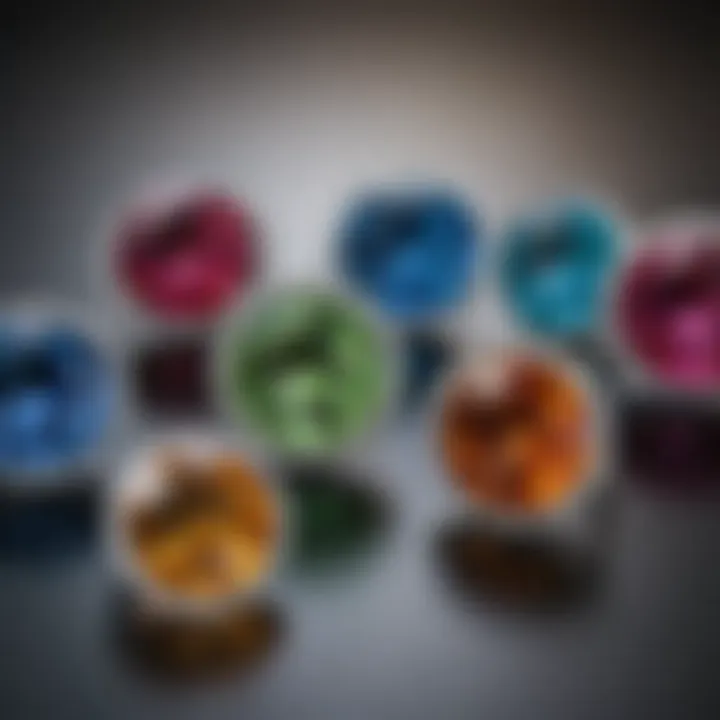
Evolution of Engagement Rings
Engagement rings have not always had the significance they hold today. In ancient civilizations, rings were used as tokens to signify ownership or commitment. Going back to the ancient Egyptians, jewelry was not just decorative; it's believed that they wore rings made from braided reeds, bone, or leather to symbolize eternal bonds.
As the centuries rolled on, the Romans introduced more ornate designs. They used iron and gold and often engraved rings with personal symbols or meaningful inscriptions, adding a layer of personalization. By the Middle Ages, engagement rings began to incorporate gemstones, offering a glimpse into their increasing symbolic value. The tradition of a diamond engagement ring, for instance, gained traction from the early 15th century, starting with Archduke Maximilian of Austria gifting a diamond ring to Mary of Burgundy in 1477. This pivotal moment not only popularized diamonds but also set a new standard for the types of materials and designs utilized in engagement rings.
Fast forward to the 20th century, the four-prong setting became a go-to choice for many. Its design allowed for a higher profile, giving the impression of a larger stone. The four prongs allowed light to penetrate the gemstone from various angles, enhancing its brilliance. It's like a spotlight pointing directly at your stone—drawing everyone's eyes to its beauty. The practicality combined with aesthetic appeal secured its place in modern jewelry design. The phrase "diamond is a girl's best friend" truly encapsulates how these rings evolved into not just status symbols but emotional tokens in the eyes of many.
Cultural Significance of the Four-Prong Setting
The cultural significance of the four-prong setting parallels its aesthetic qualities. Each prong, firmly cradling the gemstone, showcases unwavering commitment. Various cultures around the world express love and commitment through jewelry, with the four-prong setting playing a notable role. For instance, in Western societies, the transition to diamond rings as symbols of engagement signifies intentions of permanence.
Notably, the four-prong setting symbolizes strength and security in relationships—it can be seen as a metaphor for the stability and support that love brings. Its minimalist yet elegant design amplifies the beauty of the gem, embodying a deep connection between the stone and the wearer.
Here’s something intriguing: in some cultures, the style of the ring, including the number of prongs, can reflect familial values or societal expectations. For instance, a four-prong setting may symbolize balance and equality between partners. The simplicity of the design often resonates with those who appreciate understated elegance—where less is indeed more.
Gem Compatibility with Four-Prong Settings
Choosing the right gemstone for a four-prong platinum setting goes beyond aesthetics; it touches on functionality and safety. It’s essential to understand how various gems interact with this specific setting style, ensuring both beauty and durability.
Best Gemstones for Prong Settings
Certain gemstones naturally shine in four-prong settings, making them natural choices for those elegant pieces. Some of the leading players include:
- Diamond: As the quintessential choice for engagement rings, diamonds are durable and resist scratching. This hardiness complements the four-prong design, allowing maximum light to reach the gem.
- Sapphire: Known for their hardness second only to diamonds, sapphires also come in a range of stunning colors. Their robust nature means they stand up well to daily wear.
- Emerald: These captivating stones bring a sense of opulence due to their deep green hues. However, caution is necessary; their natural inclusions require careful setting to protect them effectively.
- Ruby: Another viable contender, rubies carry a symbolic value along with an exceptional ability to withstand pressure and impacts.
These gems offer an impressive balance of beauty and brawn when set in a four-prong platinum setting. Their secure positioning allows for visibility from all angles, enhancing the total visual appeal of the piece.
Considerations for Soft Stones
Not all gemstones are suitable for a four-prong setting, particularly those less durable than diamonds or sapphires. Soft stones such as opal, aquamarine, or morganite present unique challenges. Handling these gems requires an understanding of their specific properties:
- Vulnerability: Soft stones are more prone to scratches, making them a potential risk in everyday wear scenarios.
- Fragility: Some soft stones can chip or crack if not set properly, particularly under stress. This factor needs attention when considering their display in prong settings.
- Care Recommendations: Special care should include regular cleaning and, ideally, wearing them less frequently than harder stones to mitigate the risk of damage.
In summary, while the four-prong platinum setting is ideal for many sparkling options, consideration must be given when selecting softer stones. Balancing the delicate nature of these gems with the strength of a four-prong setting can truly create standout jewelry that maintains its elegance over time.
"Selecting the right gemstone is not just about color or clarity; it's about fitting it into a structure that enhances its beauty without compromising its integrity."
As one navigates the world of gem selection for four-prong settings, this understanding transforms the process from mere choice into a meditation on durability and beauty.
Customization Opportunities
Customization plays a pivotal role for those looking to express their individuality through jewelry. When it comes to four-prong platinum settings, the options for personalization are vast. Every detail, from the choice of gemstone to the intricacies of the band design, can be tailored to reflect one’s unique taste and style. This flexibility enhances the emotional connection between the wearer and the jewelry, making each piece not just an accessory but a cherished keepsake.
Tailoring Design to Personal Preferences
Tailoring designs to fit personal preferences isn’t merely about style; it’s about creating a narrative through the choices made. Individuals can select the gemstone that resonates with them—be it a radiant diamond, a vibrant sapphire, or a deep emerald. Each gem tells a story, and customizing a ring allows one to align that story with their personal journey.
Moreover, the setting can be adjusted to complement the chosen stone’s shape and color. For instance, if a client opts for a square-shaped diamond, the corners of the prongs can be designed to cradle the gem snugly, ensuring it stands out beautifully.
"A ring isn’t just a piece of jewelry; it encapsulates a moment, a memory, and a promise. Customizing it makes it uniquely yours."
From the band’s metal finish—whether a polished sheen or a matte appearance—to adding additional accents like side stones, the opportunities are limited only by one’s imagination. Sizes, widths, and engraving options can be tailored, enhancing the structure even further.
Innovative Techniques in Custom Settings
The jewelry market continuously evolves, introducing innovative techniques that allow jewelers to push boundaries. One such technique is computer-aided design (CAD), which permits precise visualization of the ring before it is crafted. This technology enables clients to see 3D models of their proposed setting, ensuring every angle meets their desire before entering a production phase.
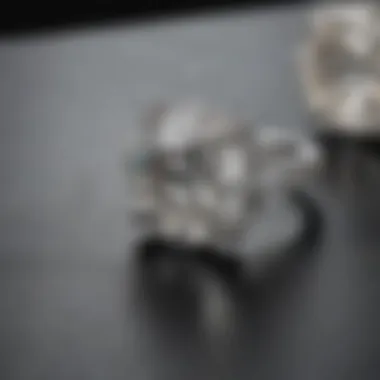
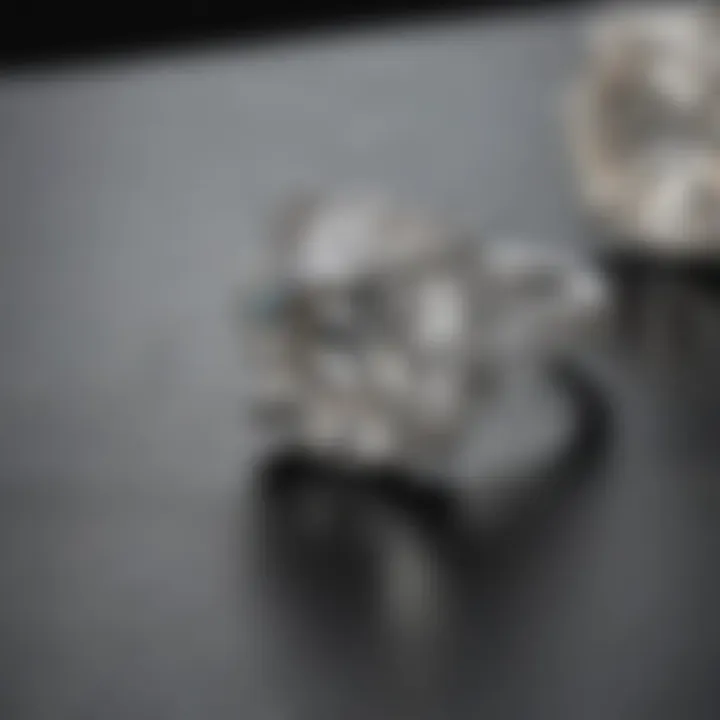
Another noteworthy technique involves advanced metal-smithing methods. For instance, techniques such as laser engraving not only add intricate designs but can inscribe messages within the band that hold personal significance. It’s an excellent way to integrate sentimental value without compromising the ring's overall aesthetic.
Furthermore, jewelers are increasingly utilizing eco-friendly practices in custom settings. This can involve sourcing recycled platinum or ethically mined gemstones, demonstrating a commitment to sustainability while still providing a beautiful and personalized product.
Maintenance and Care of Platinum Settings
Taking care of your four-prong platinum settings is essential for preserving their beauty and longevity. Platinum, known for its remarkable durability, still requires attention to keep it looking its best. Regular maintenance not only enhances the aesthetic appeal but also ensures the security of the precious gemstones it holds. The gravitational pull of sentimental value in fine jewelry cannot be overstated, and ensuring its upkeep reflects the commitment to that emotional significance.
Cleaning and Polishing Techniques
Cleaning your platinum setting isn’t as daunting as it might sound. Here are some effective techniques to keep that shine:
- Use Mild Soap and Warm Water: A simple mix of mild liquid soap with warm water can do wonders. Soak your ring for a few minutes, then gently scrub with a soft brush or cloth to remove dirt and grime.
- Ultrasonic Cleaners: While not all jewelry should go in an ultrasonic cleaner, most four-prong platinum settings can shine bright after a cycle in one of these gadgets. It’s best to consult with a jeweler to see if this method fits your specific piece.
- Professional Cleaning: At least once a year, consider taking your ring to a professional for a thorough cleaning and polishing. A jeweler has the tools to restore your platinum’s luster without risking damage.
Many owners are surprised to find how much dirt can build up over time, dulling the sparkle of the gemstones. Think of the routine cleaning as nurturing a plant; a little bit of care goes a long way towards flourishing brilliance.
"Regular care of your jewelry piece honors not just its material value but the memories it holds."
Regular Inspections and Precautions
Regular inspections of your platinum settings can help catch any minor issues before they escalate. Here are some practical steps to consider:
- Check Prongs and Settings: Every few months, inspect the prongs that hold your gemstones securely. If they look worn or loose, it’s time to consult with a jeweler to avoid losing a precious stone.
- Be Cautious with Activities: Engaging in sports or manual labor while wearing your ring is something to rethink. Platinum may resist scratches, but sudden impacts can compromise the security of your stones.
- Store Safely: When not being worn, store your platinum rings separately. A soft pouch or a lined jewelry box helps in preventing scratches from other pieces.
- Avoid Harsh Chemicals: Household cleaners can be brutal on fine jewelry. Always remove your ring when using cleaning agents or even when swimming in chlorinated water.
Overall, maintaining your four-prong platinum setting blends practicality with emotional ties. It shows care for the piece that often signifies love and commitment. Taking these steps ensures your jewelry continues to shine, echoing the memories and promises it encapsulates.
Emotional and Symbolic Significance
The emotional weight of a four-prong platinum setting extends beyond its physical beauty. This section delves into the heart of what makes this jewelry choice so resonant. With its secure grip on a precious gemstone, it embodies an unshakeable bond—be it in love, friendship, or commitment. The four-prong design not only enhances the brilliance of the gem but also fosters a deeper connection between the wearer and the stone. Engaging with this subject reveals the intricate layers of emotional significance intertwined with personal milestones and devotion.
Symbolism of the Four-Prong Setting
When it comes to symbolic meanings, the four-prong setting stands out distinctively. The number four itself often symbolizes stability and groundedness, attributes that resonate heavily in relationships. Each prong can be thought of as representing one of the four cornerstones of a solid relationship: trust, love, respect, and loyalty. This profound symbolism makes the four-prong setting an ideal choice for engagement rings, crafting a narrative that tells a story of unyielding love.
Another layer of meaning arises from the way a four-prong setting showcases the gem. The prongs lift the center stone, allowing light to pass through from all angles, illuminating the gem's brilliance. Thus, it represents not just the beauty of the relationship but also the commitment to maintaining it, by nurturing and allowing love to flourish in the light.
"Jewelry is not just an accessory. It tells the story of who you are, what you love, and the connections you cherish."
Tales of Love and Commitment
Throughout history, four-prong settings have been the backdrop for countless declarations of love. Each piece has a story, with engagement rings marking a pivotal moment in a couple's journey together. These tales often transcend time, living on through generations.
Picture a young couple, each pursuing their dreams while falling in love. The gift of a four-prong platinum engagement ring can signify a promise to support each other through thick and thin. The ring becomes a token of commitment—an object imbued with shared memories and unspoken understanding. As seasons change and life's challenges arise, the symbolism of the four-prong setting holds strong.
In many cultures, passing down a four-prong setting becomes a rite of passage, connecting generations and reminding us of familial bonds. This emotional thread weaves through each story, highlighting relationships, both new and old. Not just a piece of jewelry, but a tangible reminder of cherished moments.
Closure and Future Trends
The conclusion of an exploration into four-prong platinum settings encapsulates not just the elegance and aesthetic appeal of the design, but also sheds light on the shifting dynamics of jewelry trends. As this article underscored, these settings are more than mere mounts for gemstones; they stand as symbols of relationships, commitment, and personal style. Their suitable structure and range of benefits underscore their placement at the forefront of contemporary and classic jewelry design alike. With insights into both historical significance and emerging trends, we prepare to analyze how the four-prong setting continues to offer a blend of timelessness and modernity.
Recap of Key Benefits
A thorough understanding of the four-prong platinum setting reveals several notable advantages that contribute to its popularity:
- Optimal gemstone visibility: The four-prong design allows maximum light to penetrate the gemstone, enhancing its brilliance.
- Security: By cradling the stone from all sides, this setting type minimizes the risk of loss or damage.
- Versatility: From engagement rings to other fine jewelry, the design can adapt to various styles whether modern, vintage, or somewhere in between.
- Durability of platinum: The resilience and hypoallergenic properties of platinum make it a suitable choice for everyday wear, ensuring that pieces maintain their elegance over time.
These attributes are essential for anyone looking to invest in jewelry, making the four-prong platinum setting a sound choice.
Future of Ring Settings in Jewelry Design
As we look ahead, the future of ring settings, particularly the four-prong design, seems bright. Various factors are influencing changes in jewelry design, including:
- Sustainability: Many consumers are leaning towards ethically-sourced metals and lab-grown gemstones. This shift is likely to influence how jewelers create settings in a way that is both eco-friendly and visually appealing.
- Customization: Technology allowing for personalized designs will likely see a broader use of innovative approaches in creating prong settings. Custom designs can appeal greatly to individuals seeking unique pieces that reflect their personality or love story.
- Fusion of styles: The boundary between traditional and modern styles is becoming increasingly blurred. Jewelers might experiment more with fusion designs that incorporate elements of the four-prong setting while maintaining modern aesthetics.



